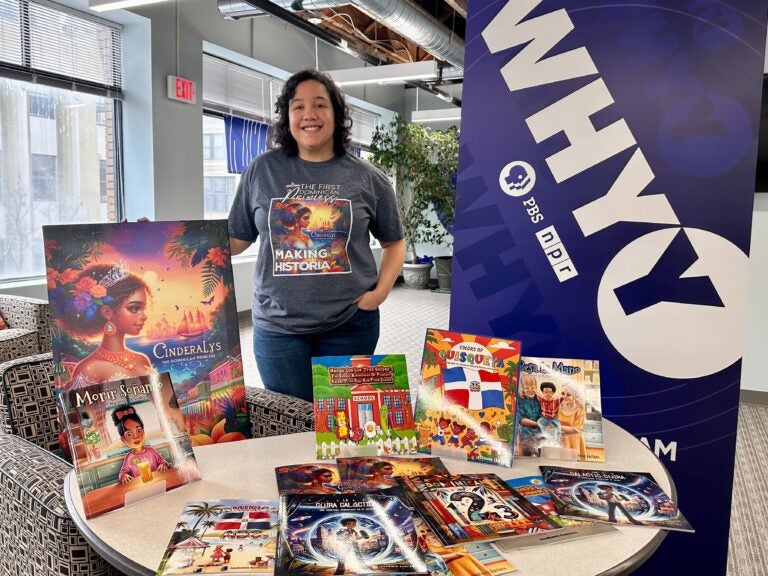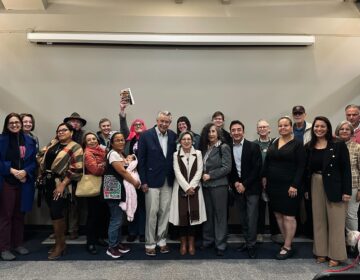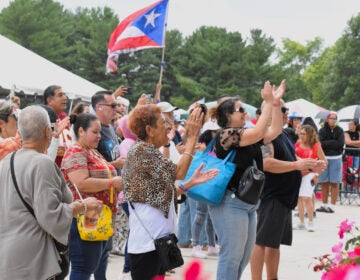Wilmington author tackles Latino representation gap with children’s books featuring Dominican culture
Jasdomin Santana champions diversity in children's literature by incorporating Dominican culture into her storytelling.
Listen 1:18
Jasdomin Santana is displaying her book collections, including her latest release called “Cinderalys.” She has 16 books that include Spanglish, bilingual Spanish and English editions, and coloring books. (Johnny Perez-Gonzalez/WHYY)
From Philly and the Pa. suburbs to South Jersey and Delaware, what would you like WHYY News to cover? Let us know!
In the world of children’s literature, stories featuring Latinos or written by Latino authors have historically been scarce. And while a recent study shows more Latino characters are being seen in kids books, there’s still room for improvement.
The Cooperative Children’s Book Center at the University of Wisconsin-Madison found Latino representation in children’s books has increased from 2% in 1994 to 11% today.
Wilmington author Jasdomin Santana is working hard to accelerate that progress and expose young readers to a more diverse array of cultural perspectives and experiences.
“Representation to me is at the forefront, especially because I have young kids and I want them to grow up in a world where they don’t feel like they’re outsiders, or like they need to hide a part of themselves,” Santana explained. “I grew up in a time where I didn’t see much of myself [in books], but I think we are further ahead, but I still think we have a lot of work to do.”
Born and raised in New York, with a childhood that included regular summer trips to the Dominican Republic and later living in New Jersey, Santana’s upbringing deeply influenced her writing journey. Now settled in Wilmington for nearly two years and raising two children under the age of two along with her husband, Santana’s personal experiences continue to inspire her work as an author.
Living away from family posed a unique challenge, prompting her to find ways to share her culture with her children.
“How can I share a little bit about our culture if they’re not around family and maybe they will never visit the Dominican Republic [since] my upbringing was very different,” she thought. “I’m very Americanized, too. And then I feel like my kids are even further removed from the Dominican Republic.”
Motivated to both culturally educate children and support first-generation parents like herself, Santana embarked on a journey of writing stories that reflect her heritage. After just six months as an author, she has already published 16 books.
“I started off with my first book called ‘Mangu Con Los Tres Golpes’ because that is a very well-known breakfast in the Dominican community,” she said of the book that’s subtitled, “The School Adventures of Plantain, Salami, Fried Egg, and Fried Cheese.”
“It was, one, about introducing them to food, so there’s a recipe at the end of the book, but also about an experience that I had growing up around trying to fit in when I didn’t know English as my first language.”
All of Santana’s books delve into her Dominican roots, exploring traditions, foods, values and dialects.
“The overall theme is about exposing young readers and also parents to the Dominican culture,” she said.
Her latest book, “Cinderalys,” puts a Dominican twist on the Cinderella tale, with Santana envisioning her daughter as a Dominican princess. Santana sought to fill a gap in representation of Dominican princesses compared to mainstream characters.
“One of the principal themes is a huge carnival that we have in the Dominican Republic called Carnaval de la Vega. You will learn what the carnival is and why it’s important,” she said. “Two central points in the book are surrounding the gemstone that’s an amber. So that is our national gemstone, I talked a little bit about what that is, why it’s important and then our national flower, which is la flor de Bayahibe.”
“So she doesn’t lose a slipper, but she loses this very important necklace that combines those themes,” she said.
After its release, she noted that the book has become a source of inspiration within the Latino community, particularly among young girls who have chosen “Cinderalys” as the theme for their quinceañera — a pivotal moment in their early lives.
In her work, Santana also addresses colorism within Dominican culture by portraying Cinderalys as a brown-skinned Dominican girl, which contrasts with the depiction of lighter-skinned Dominican characters in her other books.
“A very big component that I’m trying to convey going forward is the fact that we don’t all look the same. There is not one version of being Dominican and we truly do look like everything under the sun,” she said.
Looking ahead, Santana hopes to see her books integrated into school programs and perhaps even adapted into plays or animated films, furthering her mission of cultural representation and inclusivity in children’s literature.

Saturdays just got more interesting.
WHYY is your source for fact-based, in-depth journalism and information. As a nonprofit organization, we rely on financial support from readers like you. Please give today.







